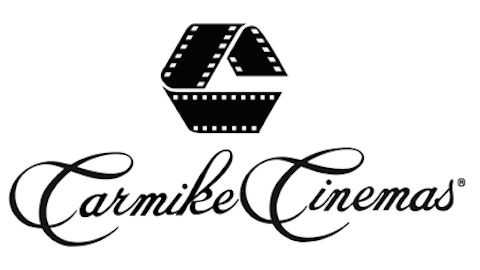There are also multiple opportunities to expand revenues. Some smaller markets have not fully deployed digital/3-D. Rolling out Carmike Cinemas, Inc. (NASDAQ:CKEC)’s RealD premium offering or merely upgrading is an opportunity to increase revenue. Concessions are another important way to eke value out of rural markets. Carmike is highly skilled at doing so with concessions per patron among the highest in the industry. It has a number of proven initiatives that could be rolled out.
The final point is Carmike’s 20% stake in Screenvision, the number two on-screen advertising vehicle. The largest competitors, National CineMedia (NASDAQ:NCMI) is roughly half-owned by Regal, AMC and Cinemark counting about 18,000 to Screenvision’s 14,000. NCM’s revenue base is roughly double Screenvision’s due to its dominant position in high-volume markets. Nonetheless, this represents a significant, off-balance sheet source of value which grows with Carmike.
The risks
However, investors should consider some negatives. Being the small-town operator has some disadvantages. For one, Carmike is more exposed to low-income customers meaning it cannot meet the high ticket prices of bigger chains like Regal and AMC.
Being exposed to smaller markets also means potentially higher costs at the theater level as well as increased reliance on high-profile releases; both of these factors increase operating leverage.The lack of high-profile releases has been particularly damaging for recent figures especially given the tough comps of last year (i.e. Hunger Games).
Another disadvantage is less screens per theater, currently at 9.9 against 12+ for the industry’s top three. Industry averages also suggest that smaller chains, the potential acquisitions, have less than seven screens on average. Acquisitions should be assessed on a case-by-case basis but it is not clear how the company can expand screens per theater significantly given national averages.
However, the company has a strong new-build pipeline. It has been creative in its use of capital securing upfront money from Entertainment Properties Trust, exploiting the natural advantages of having a cinema chain like Carmike as a tenant.
As suggested earlier, competition is also increasing. In acquisitions, Regal acquired Hollywood and Great Escapes. In the Rave acquisition, Carmike Cinemas, Inc. (NASDAQ:CKEC) did not get the full company but assets were parceled out among several bidders. Finally, Cinemark has also begun making inroads into Carmike’s markets.
The advantage that Carmike holds is the experience in managing theaters in these rural locations. As already mentioned, the operating model in rural areas appears to be substantially different. It is not possible to charge metropolitan prices in rural markets despite often being the “only game in town”. Concessions are, therefore, more important in rural locations and Carmike has built up significant experience in maximizing these revenues. The bigger chains, particularly Regal and AMC, have far less experience in this area. Rural theaters also have significantly more operating leverage and volatility in sales. Keeping growth and acquisition costs at a minimum is again key. Chains like Regal and AMC might have expertise in keeping acquisition costs down but do not have experience in running theaters with fewer than nine screens. The consolidating trend plays into Carmike’s niche, not Regal or AMC, because it is mainly small chains that are being acquired. Carmike Cinemas, Inc. (NASDAQ:CKEC) has the most experience in operating these locations, can bring the most value to these operations, and can therefore bid more aggressively, and accurately, than competitors.
Conclusion
While there are some questions about how Carmike Cinemas, Inc. (NASDAQ:CKEC) can achieve its goals, the company is trading at a reasonable valuation both against peers and given the prospect of its growth strategy. Moreover, it has clear room to cut costs which it has achieved already. In the short term, trends are favorable, with a big slate of big movies. In the average year, there are 12-15 movies with $100 million-plus budgets. This year there are 22. For a company working in a small niche with a disciplined strategy and proven management, the potential is huge.
Michael Russell has no position in any stocks mentioned. The Motley Fool has no position in any of the stocks mentioned.
The article Can You Make Money in This ‘Dying’ Industry? originally appeared on Fool.com.
Copyright © 1995 – 2013 The Motley Fool, LLC. All rights reserved. The Motley Fool has a disclosure policy.



